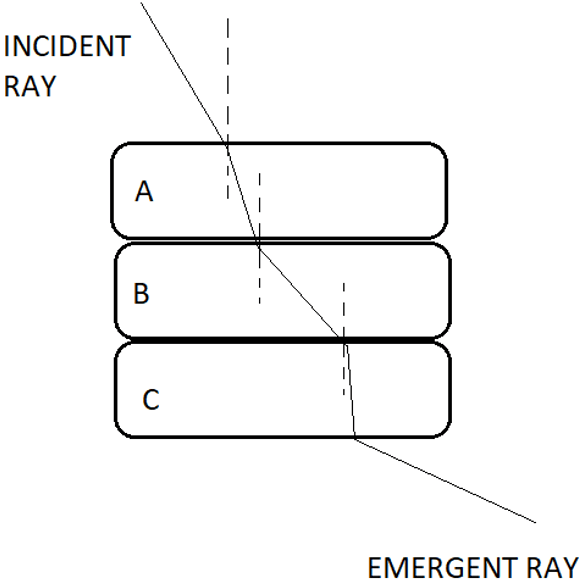This set of Engineering Physics Multiple Choice Questions & Answers (MCQs) focuses on “Velocity of Light”.
1. The velocity is higher in the medium whose refractive index is ______________
a) Lower
b) Higher
c) 1
d) Same as the first medium
View Answer
Explanation: We know, that the speed of light in a medium = speed of light in vacuum/refractive index of the medium. Hence, as the refractive index is lower, the speed of the light in that medium is higher and vice versa.
2. If the light is incident on an optically denser medium, then what is the relationship between the angle of incidence, I, and the angle of refraction, r?
a) r > i
b) i > r
c) i = r
d) r = 0
View Answer
Explanation: If the light is incident on an optically denser medium, then the speed of light will be lower in that medium. Hence, the refracted ray would be bent towards the normal. Thus, the angle of refraction would be less than the angle of incidence.
3. When light is incident on a parallel-sided slab on one side, the shift between the incident and emergent ray is called as _____________
a) Parallel Shift
b) Ray Shift
c) Lateral Shift
d) Normal Shift
View Answer
Explanation: The emergent ray is parallel to the incident ray. The perpendicular distance between the emergent ray and the incident ray is called the lateral shift.
4. Arrange the slabs in the increasing order of the refractive index.

a) A > B > C
b) B > A > C
c) C > A > B
d) C > B > A
View Answer
Explanation: As we know, the ray bends towards the normal if the medium is optically denser. Hence, by observing the shift in the direction of incident light between A and B, we realize that the refractive index of A is greater than B. Similarly, R.I of C is greater than A and B. Thus, the right order is C > A > B.
5. The speed of light in medium A is 1.4 X 108m/s. What is the refractive index of the medium?
a) Colored Image form
b) Black and white image form
c) 3-D image form
d) Coded form
View Answer
Explanation: We know, speed of light in a medium = c/refractive index of the medium
Therefore, mew = c/v
= 3 X 108/ 1.4 X 108
= 2.16.
6. The unit of refractive index is _____________
a) m/s
b) radians
c) s-1
d) no unit
View Answer
Explanation: The refractive index does not have a unit. It is simply the ratio of the velocity of light in vacuum and the velocity of light in the respective medium. Thus, it has no unit.
7. What is the difference between the actual sunset and apparent sunset?
a) 2 seconds
b) 30 seconds
c) 1 minute
d) 2 minutes
View Answer
Explanation: The refractive index of the earth’s atmosphere relative to vacuum is about 1.00029. Thus, the speed of light is less in the earth’s atmosphere as compared to vacuum. Hence, there is a shift in the direction of the incident light, and due to that there is a 2 minutes’ time difference between the actual sunset and apparent sunset.
8. A light is incident on a glass slab. The angle of incidence is 54° while the angle of refraction is 30°. What will be the speed of light in the glass slab?
a) v = 1.85 X 108m/s
b) v = 2.85 X 108m/s
c) v = 3.85 X 108m/s
d) v = 4.85 X 108m/s
View Answer
Explanation: Using Snell’s law, refractive index of glass slab = sin i/sin r
Also, the refractive index of glass slab = c/v
Therefore, c/v = sin i/sin r
v = c X sin r/sin i
v = 3 X 108X sin 30o/ sin 54o
v = 1.85 X 108m/s.
9. The refractive index of a parallel glass slab is 1.57. A light, from medium Y, is incident on the glass slab. If the angle of incidence is 37°, then the angle of emergence, when the light emerges back to medium Y, is ____
a) 37°
b) 45°
c) 54°
d) 60°
View Answer
Explanation: In the given case, the light is initially in medium Y. It strikes the glass slab at 37° and later emerges back at medium Y at a certain angle to the normal, called angle of emergence. Now, since the opposite sides of the glass slab are parallel, the incident ray should be parallel to the emergent ray. Hence, the angle of incidence should be equal to the angle of emergence.
Hence, the angle of emergence = 37°.
10. Which color appears at the top when white light is incident on a glass prism?
a) Violet
b) Indigo
c) Red
d) Yellow
View Answer
Explanation: Red color has the highest wavelength. Subsequently, it’s speed is maximum in a glass prism. Thus, it suffers the least diversion from its path, compared to other and emerges at the top of the spectra. This phenomenon of splitting of light is known as dispersion.
Sanfoundry Global Education & Learning Series – Engineering Physics.
To practice all areas of Engineering Physics, here is complete set of 1000+ Multiple Choice Questions and Answers.
If you find a mistake in question / option / answer, kindly take a screenshot and email to [email protected]
